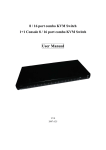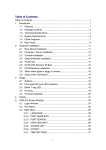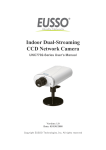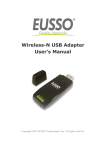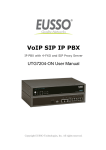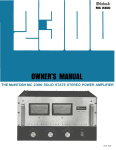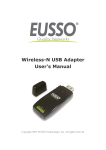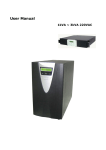Download Manual - EUSSO Technologies, Inc.
Transcript
1+1 Console 8/16 ports combo VGA KVM Switch UKS8108-ROT & UKS8116-ROT User Manual V3.0 Copyright EUSSO Technologies, Inc. All rights reserved. 1+1 Console CAT5 KVM Switch Contents 1. Introduction............................................................................................................................... 4 1.1 Main Features...................................................................................................................... 4 1.2 Package Contents ................................................................................................................ 5 1.3 Product Line........................................................................................................................ 5 1.4 Front Panels ........................................................................................................................ 7 1.5 Port LED Indications .......................................................................................................... 7 1.6 7-seg BANK LED............................................................................................................... 7 1.7 Buttons ................................................................................................................................ 8 1.8 Back Panels ......................................................................................................................... 8 2. Hardware Installation............................................................................................................... 9 2.1 Desktop or Rack Mount ...................................................................................................... 9 2.2 Computer/Server Installation .............................................................................................11 2.2.1 CAT5 KVM on Host Side .......................................................................................... 11 2.2.2 3-in-1 VGA Cable Installation ...................................................................................12 2.3 Console Installation .......................................................................................................... 13 2.3.1 Local Console ............................................................................................................13 2.4 Optional Remote Console Installation .............................................................................. 13 2.4.1 IP Module...................................................................................................................13 2.4.2 CAT5 Transmitter Module .........................................................................................14 2.4.3 CAT5 KVM Receiver (R-Box) ..................................................................................14 2.5 Power Up Sequence .......................................................................................................... 15 2.6 Daisy Chain Connection ................................................................................................... 16 3. Usage ........................................................................................................................................ 18 3.1 Hotkey Commands and OSD Operations ......................................................................... 18 3.2 DDC function.................................................................................................................... 18 3.3 Hot Plug ............................................................................................................................ 18 3.4 Firmware Upgrade ............................................................................................................ 19 4. 5. Technical Specifications ......................................................................................................... 20 Cable Connectors .................................................................................................................... 21 5.1 3-in-1 VGA Cable ............................................................................................................. 21 5.2 PS/2 keyboard to USB Changer........................................................................................ 21 5.3 Daisy Chain Cable ............................................................................................................ 21 5.4 CAT5/5E/6 Straight Through UTP/STP Cable ................................................................. 22 5.5 DC2.5M to DB9F Cable ................................................................................................... 22 6. 7. 8. Troubleshooting....................................................................................................................... 23 Glossary ................................................................................................................................... 25 Certifications ........................................................................................................................... 26 2 / 26 1+1 Console CAT5 KVM Switch Figures Figure 1. Figure 2. Figure 3. Figure 4. Figure 5. Figure 6. Figure 7. Figure 8. Figure 9. Figure 10. Figure 11. Figure 12. Figure 13. Figure 14. Figure 15. Figure 16. Figure 17. Front Panels of the Product Line .................................................................................... 6 Back Panels of the Product line ...................................................................................... 6 Footpads Installation ....................................................................................................... 9 Rack Mount Installation -1 ............................................................................................. 9 Rack Mount Installation -2 ........................................................................................... 10 Computer/Server Installation .........................................................................................11 3-in-1 VGA cable .......................................................................................................... 12 3-in-1 VGA Cable and PS/2 to USB Changer .............................................................. 12 Local Console Installation ............................................................................................ 13 IP-Module ................................................................................................................. 14 Daisy Chain Connection ........................................................................................... 16 Daisy Chain through Computer Port......................................................................... 17 3-in-1 VGA Cable Connectors.................................................................................. 21 PS/2 keyboard to USB Changer................................................................................ 21 Daisy Chain Cable .................................................................................................... 21 CAT5/5E/6 Straight Through Cable Connector (8P8C)............................................ 22 DC2.5M to DB9F Cable ........................................................................................... 22 3 / 26 1+1 Console CAT5 KVM Switch 1. Introduction The 1+1 Console 8/16-port KVM switch can control attaching servers and computers from local or remote console. This KVM switch is loaded with features such as one local console port, plus one optional CAT5-based remote console port or one optional IP-based remote console Port, Daisy Chain, On Screen Display (OSD) Menu, Password security, Hot key Control, Push Button and Auto Scan Control. It has complete keyboard and mouse emulation for simultaneous computer boot-up processes. With the CAT5-based remote console port you can remotely control servers and computers 1000 feet away. In other words, you can locate your monitor, keyboard and mouse up to 1000 feet away from the KVM switch. The built-in CAT5 transmitter synthesizes VGA monitor and keyboard/mouse signals, and transmit the signals to the remote CAT5 receiver over the popular LAN CAT5 cable. With the IP-based remote console port you can control one or many computers locally at the server site or remotely via the Internet using a standard browser. You can securely gain BIOS level access to systems for maintenance, support, or failure recovery over the Internet. Communication is secure via SSL encryption. The 1+1 console is designed as one control two viewers. Both local console and remote console can access and view the same computer port, but only one console control at a time. These two consoles are operating on first come first served basis, the non-controlling console will mirror the screen from the controlling console. If the controlling console does not have keyboard or mouse activity for 2 seconds, the other console may take over the control right. 1.1 Main Features 1+1 Console 8/16-port KVM switch Support full CAT5 interface on all computer ports for reducing KVM cable bulk Support one local console plus one optional remote console (CAT5 or IP) Locate CAT5 console up to 1000 feet (300 meters) away from KVM switch with superior auto-adjust RGB signals capability Support Microsoft Windows, Netware, Unix, and Linux Support iMAC, Power MAC and Sun Micro Systems with USB port No Software Required – easy computer selection via On Screen Display (OSD) Menu, Push Buttons, Hotkeys Provide various Hotkey (Scroll-Lock/ Caps-Lock/ Num-Lock/ Alt/ Ctrl/ Win) for switching 4 / 26 1+1 Console CAT5 KVM Switch 1.2 1x 1x 1x 1x 1x 1x 1.3 computer port and other control functions, so Hotkey function can be used in various types of keyboards, and to avoid Hotkey duplicate problem Support two levels of password security protections Provide ACL (Access Control List) security function, store up to 8 independent ACLs of controllable computer lists Hot Plug --- add or remove connected computers without powering off the KVM switch or computers Plug-n-Play monitor support Keyboard status restored when switching computers Support Daisy Chain function with both Bus (8-layer) and Tree (2-layer) topologies Package Contents KVM Switch Unit CD-ROM (User manual, QSG) AC to DC Power Adapter Rack Mount Kit Footpads set DC2.5M to DB9F Cable Product Line Models UKS8108-ROT 1+1 console 8-port, combo VGA, USB local console UKS8116-ROT 1+1 console 16-port, combo VGA, USB local console Optional Modules UKS8500-C5 CAT5-T module UKS8500-IP KVM over IP module 5 / 26 1+1 Console CAT5 KVM Switch Figure 1. Front Panels of the Product Line UKS8108-ROT (1+1 Console, 8 ports combo VGA KVM switch with USB local console) UKS8116-ROT (1+1 Console, 16 ports combo VGA KVM switch with USB local console) Figure 2. Back Panels of the Product line 6 / 26 1+1 Console CAT5 KVM Switch 1.4 Front Panels LEDs for each Host Port 7-seg LED for Bank Identification Port Number Seclect Button Bank Select Button Reset Button 1.5 Port LED Indications There are two LED’s for each port: ■ ONLINE LED: The Red LED on indicating a Computer is connecting to the port. Notice: The PC99 Computer always power on the USB or PS/2 ports and turn on Red LED even if the Computer is not power on. ■ SELECT LED: The Green LED on indicating the port has been selecting. The Green LED will be flashing if there is no Computer connected to the port. 1.6 7-seg BANK LED The 7-segment BANK LED indicates the selected bank. Maximum 8 banks can be daisy chained. In the daisy chain configuration, there are two methods to select the bank (KVM unit) you want to operate: Hotkey and OSD. 7 / 26 1+1 Console CAT5 KVM Switch 1.7 Buttons and Operations There are 11 push buttons on the front panel. The operations described in below. (1) The “BANK” is the Bank Select Button. You can select to the required bank number by press the “BANK” button. The current accessed bank will be displayed at the 7-Segment LED. The bank select were from 1 to 8 and go back to 1 cycling. It will increase the bank number from the current selected bank to the next bank if you pressed the “BANK” button once. (2) The “1”, “2”, “3”, “4”, “5”, “6”, “7”, “8”, “9”, “0” are the port number select buttons You can select to the required port number by - Press the 2 digit port number to switch the port directly. For example if you are in port 1 now, press “0” then “6” will switch to the port 6 immediately. - Press the port number and wait for 2 seconds to switch the port. At this case, you can only press single digit to select to the destination if the port number is between port 1 to port 9. (3) If you pressed the invalid operation, the system will stay at the previous selected port. (4) RESET: Press the “5” and “0” button simultaneously will restart the firmware of the KVM switch. 1.8 Back Panels Local Console Keyboard/Mouse Ports Local Console VGA Port / Daisy Chain Out Daisy Chain In Flash Upgrade Port DC Power Jack Remote Console Port (CAT5 T-Module) 8 / 26 Connector for each Host Port 1+1 Console CAT5 KVM Switch 2. Hardware Installation Before installation, please make sure all of peripherals and computers have been turned off. 2.1 Desktop or Rack Mount The KVM switch unit can be placed on desktop or rack mounted. Desktop Stick the self-adhesive footpads that come with the package to the unit’s bottom panel at the four corners. To install footpads, please turn upside down; and refer to the following instructions properly for installing the footpads. Figure 3. Footpads Installation Rack Mounting The KVM switch unit can be mounted on 19”/1U rack: 1. Screw the mounting brackets into the sides of the unit at the front, as shown in the diagram below. Take note of the length of your cables so that your computers, KVM Switch, keyboard, mouse and monitor are distanced properly. Figure 4. Rack Mount Installation -1 9 / 26 1+1 Console CAT5 KVM Switch 2. Slide the unit into the rack and secure it to the rack. Figure 5. Rack Mount Installation -2 10 / 26 1+1 Console CAT5 KVM Switch 2.2 Computer/Server Installation 2.2.1 CAT5 KVM on Host Side Please refer to the “CAT5 Extender User Manual” for details. The figure below depicts the computer/server installation. Figure 6. Computer/Server Installation 11 / 26 1+1 Console CAT5 KVM Switch 2.2.2 3-in-1 VGA Cable Installation Each computer port connector is HDDB15 type. The 3-in-1 VGA cable has a HDDB15 male connector at one end. Plug it into computer port on the rear of KVM switch. The other end of input cable has three connectors: a HDDB15 male type for computer video, a purple mini din 6-pin PS/2 connector for keyboard and a green mini din 6-pin PS/2 connector for mouse. Plug these three connectors into the respective ports of computer. Repeat the same procedure for all other computers. (a) PS/2 computer --- Plug in PS/2 mouse connector to computer mouse port, the PS/2 keyboard connector to computer keyboard port. Do not hot plug PS/2 port. If you must do that make sure PS/2 mouse first then the PS/2 keyboard. Figure 7. 3-in-1 VGA cable (b) USB computer --- connect PS/2-USB changer to PS/2 keyboard connector, then plug the changer into available USB port. This single USB port can communicate both keyboard and mouse signals. It works as a standard HID (Human Interface Device), no extra driver needed. PS/2-USB Changer Figure 8. 3-in-1 VGA Cable and PS/2 to USB Changer Note: It is recommended to power off all the computers and server before the installation. If we can not turn off the computer, for PS/2 computer, please plug in T-dongle connectors in the following order: firstly PS/2 mouse connector, secondly PS/2 keyboard connector, thirdly the VGA connector to the computer. 12 / 26 1+1 Console CAT5 KVM Switch 2.3 Console Installation 2.3.1 Local Console Connect the monitor to the HDDB15 female port on the back of the KVM unit labeled with the monitor symbol at the Local Console connector. There may be USB local console or PS/2 local console. For USB local console, connect the USB keyboard to either one of USB local port and USB mouse to the other USB port. These USB ports are special designed for keyboard and mouse, and can not work with USB hub or other USB devices. For PS/2 local console, connect keyboard to purple PS/2 port and mouse to green PS/2 mouse port. There is a Daisy chain port under VGA ports. Figure 9. Local Console Installation 2.4 Optional Remote Console Installation 2.4.1 IP Module Please refer to “IP KVM Module User Manual” for details. IP Remote Console Installation: Power off the KVM switch firstly. Remove the cover of the add-on slot, slide in the IP Module and make sure the module is fully inserted into the slot. The IP Module redirects local keyboard, mouse and video data to a remote administration console. It allows you to control one or many computers locally at the server site or remotely via the Internet using a standard browser. 13 / 26 1+1 Console CAT5 KVM Switch Figure 10. IP-Module Figure 11. Serial Power Control The IP Module comes with a serial port for connecting to any serial device, such as serial PDU (Power Distribution Unit) to provide remote power control, such as power on, power off, and power cycle for the connected computers/servers. 2.4.2 CAT5 Transmitter Module CAT5 Remote Console Installation: Power off the KVM switch firstly. Remove the cover of the add-on slot, slide in the CAT5 transmitter module and make sure the module is fully inserted into the slot. To extending your console up to 1000 feet away by connecting the CAT5 cable to the R-Box in the remote end. Please refer to the “CAT5 Extender User Manual” for details. 2.4.3 CAT5 KVM Receiver (R-Box) Please refer to the “CAT5 Extender User Manual” for details. 14 / 26 1+1 Console CAT5 KVM Switch 2.5 Power Up Sequence Double check whether all cables/connectors are properly connected. You can check the color of keyboard and mouse connectors to ensure the connectors and cables are connected correctly. The recommended Power Up sequence is as follows: Monitor, KVM Switch, finally the Computers. Verify that all servers connected to the KVM Switch are powered on. If any connected servers have not been powered on, it is okay to do so at this time (servers can be powered on simultaneously). The KVM Switch emulates both a mouse and keyboard on each port and allows your server to boot normally. When power on the KVM switch, you will see the SELECT LED of Port 1 lights up, and hear a beep sound. If you encounter an error, check your cable connections for that server and reboot. If the problem persists, please refer to the chapter “Troubleshooting” in this User Manual. 15 / 26 1+1 Console CAT5 KVM Switch 2.6 Daisy Chain Connection Use one end of daisy chain cable to connect to the Daisy Chain port of Master KVM switch and connect the other end of daisy chain cable to the Local Console port of the next Slave KVM switch. Please repeat the connection procedures for next Slave KVM switch. You can daisy chain up to eight banks in maximum. Note: The Daisy Chain cable is 15 lines fully connected. This is a special VGA cable, normal VGA cable have unconnected lines. Bank 1 (Master) Bank 2 (Slave1) Bank 3 (Salve2) Figure 12. Daisy Chain Connection The console OSD menu will show only the port information of the master KVM switch. When the master unit starts up, it will query all daisy chained Slave units, and automatically set up the Bank ID for each Slave unit. So the 7-seg LED on the Master unit will display 1, Slave 1 will display 2, Slave 2 will display 3, and so on. If not so, please reset the Master unit to update the Bank ID immediately. Hot Plug function is supported in daisy chain connection. You can also daisy chain through computer port. This daisy chain can work with other brand of KVM switch, but you need to change the Hotkey of slave KVM switches so that the master and 16 / 26 1+1 Console CAT5 KVM Switch slave KVM switches do not use the same Hotkey. Figure 13. Daisy Chain through Computer Port 17 / 26 1+1 Console CAT5 KVM Switch 3. Usage Now that you have connected your console and servers to your KVM Switch, it is ready for use. You can control the KVM switch by three methods: 1. Using push buttons located on the front panel of the KVM Switch 2. Through the OSD (On-Screen Display) 3. Using hot-key commands through the console keyboard It takes approximately 1-2 seconds for the video signal to refresh after switching servers. Re-synchronization of the mouse and keyboard signals also occurs. This is normal operation and ensures that proper synchronization is established between the console and the connected servers. When you power on KVM switch, if the security function is enabled (default is disabled), it will prompt a Login window waiting for user name and password. You need to pass the authentication so can control the KVM switch. 3.1 Hotkey Commands and OSD Operations Please refer to “Hotkey and OSD User Manual” for details. 3.2 DDC function The KVM Switch support DDC (Display Data Channel). DDC is a VESA standard for communication between a monitor and a video adapter. Using DDC, a monitor can inform the video card about its properties, such as maximum resolution and color depth. The video card can then use this information to ensure that the computer is presented with valid options for configuring the display. Note: The DDC function of KVM Switch will dynamically detect and copy the DDC data from the monitor that attached to the LOCAL console port, and that data will feed to the host computer during computer startup. 3.3 Hot Plug The KVM Switch supports “Hot Plug” function for USB keyboard and mouse connectors. Note: ■ Normally, PS/2 port is not Hot pluggable. ■ Normally, USB port is Hot pluggable, but some OS (Operation Systems), like Sun Micro and some Unix and Linux, do not support USB Hot Plug function. If you apply Hot Plug to this kind of OS, it will cause unpredictable behavior or shut down the Computer. Before attempting to use Hot Plug, please make sure OS and mouse software driver support the Hot Plug function. 18 / 26 1+1 Console CAT5 KVM Switch 3.4 Firmware Upgrade Please follow the following procedures: 1. Power off the KVM switch. 2. Prepare the DC2.5M/DB9F cable, plug the DC2.5 end to the KVM switch’s phone jack (marked Flash) and the DB9F end to PC serial DB9 port. 3. Power on the KVM unit. The KVM unit now will be in Flash mode, waiting for firmware download. 4. Run “Firmware Upgrade Utility.exe” 5. Click Browse to select the FW upgrade file. Please make sure you select the correct FW upgrade file. Click Write Flash to start to upgrade. The upgrade process takes about 6 seconds, then display WRITE OK if complete the upgrade successfully. 6. 7. Disconnect the DC2.5M/DB9F cable from the KVM unit and PC. Now the KVM unit should be running on the new firmware. The FW version can be seen on the bottom-right corner of the PORT NAME OSD window. 19 / 26 1+1 Console CAT5 KVM Switch 4. Technical Specifications Feature Specification KVM Type Combo VGA Host Port Connector VGA Host Ports 8/16 Console Type USB or PS/2 Max. Distance (KVM switch -- Host) 16 feet (5m) Video Resolution (Local Console) 1920 x 1440 Video Resolution (Remote Console) 1680 x 1050 for CAT5-Based 500 feet remote console (ET101-C01), 1280 x 1024 for CAT5-Based 1000 feet remote console (ET101-C04), 1600 x 1200 for IP-Based remote console Console Ports Flash Port CAT5-Based Remote Module 1 Local console, plus 1 Optional Modules: CAT5-Based or IP-Based Remote Console DC2.5F ■ RJ-45 Connector ■ CAT5 console up to 1000 feet away from KVM switch with superior auto-adjust RGB signals capability ■ RJ-45 8P8C for 10/100M Ethernet IP-Based Remote Module ■ DB-9 male for Configuration console, Modem, Null modem, and serial power control ■ Mini USB 2.0 receptacle Daisy Chain ■ Support Daisy Chaining with both Bus (8-layer) and Tree (2-layer) topologies ■ Connector DB15 (Female Type) Computers Selection On Screen Display (OSD) Menu, Hot Key, Push Button Hotkey Provide various Hotkey (Scroll-Lock/ Caps-Lock/ Num-Lock/ Alt/ Ctrl/ Win) Computer Port LED’s 2 LED’s per Host port: ON LINE (Red), SELECT (Green) 7-seg LED 1 set for Bank display Security Provide ACL (Access Control List) security function, store up to 8 independent ACL’s of controllable computer lists Multilingual OSD (On Screen Display) control 8 languages (English, France, Germen, Spanish, Italian, Russian, Japanese, Simplified Chinese) Auto-Scan Intervals 5 ~ 99 Sec. Keyboard Emulation PS/2 or USB Mouse Emulation PS/2 or USB Max. Connected Computers Up to 8192 Housing Metal Power DC Power adapter : 12V, 1A Operation Temperature 0 ~ 50℃ 20 / 26 1+1 Console CAT5 KVM Switch Storage Temperature -20 ~ 60℃ Humidity 0~80%, Non-Condensing Mechanical 19” Rackmount, 1U 444.5 * 160 * 44.3 Dimension (mm) 5. Cable Connectors 5.1 3-in-1 VGA Cable HDDB15 male to one HDDB15 male plus two mini din 6-pin PS/2 connectors. Figure 14. 3-in-1 VGA Cable Connectors 5.2 PS/2 keyboard to USB Changer PS/2 (keyboard) to USB (keyboard and mouse) changer. Figure 15. PS/2 keyboard to USB Changer 5.3 Daisy Chain Cable VGA Cable: HDDB15 Male to Male Figure 16. Daisy Chain Cable Note: Daisy chain needs the cable 15 lines fully connected. This is a special VGA cable, normal VGA cable have unconnected lines. Please contract your dealer for Daisy chain cable. 21 / 26 1+1 Console CAT5 KVM Switch 5.4 CAT5/5E/6 Straight Through UTP/STP Cable Figure 17. CAT5/5E/6 Straight Through Cable Connector (8P8C) 5.5 DC2.5M to DB9F Cable This cable is used for Flash firmware upgrade. Figure 18. DC2.5M to DB9F Cable 22 / 26 1+1 Console CAT5 KVM Switch 6. Troubleshooting 1. No LED display on KVM Switch ■ Make sure the power adapter plugged into the KVM Switch. If the LED’s still won’t light, perform soft reset to KVM switch. ■ 2. 3. Power cycle KVM switch. The computer has started up, but keyboard or mouse won’t work Make sure your keyboard and mouse work fine if directly plugged into the computer. PS/2 computer --- keyboard and mouse are not hot pluggable, please make sure PS/2 cable are well connected then reboot the computer. USB computer ---- please unplug and plug in the USB connector, wait few seconds for USB bus emulations and start up process to cmplete. Do not press any keys on the keyboard while the selected computer is booting up. Otherwise it might cause the keyboard error or keyboard is not detected at Host side. Try a different keyboard, but use only 101/102/104-key keyboard. Power cycle R-Box or KVM switch. Avoid moving the mouse or pressing the mouse buttons when switching ports. No video signal is displayed on the monitor. ■ Connect your monitor directly to the server to verify that your monitor is functioning properly. ■ Please check if all connectors are connected properly ■ The power adapter is not connected to the R-Box or KVM switch. ■ Use hotkey "SPACE" to bring up the OSD, and confirm the port is selected and connected to a server ■ See next item, make sure the computer VGA output resolution match with the monitor’s 4. resolution The computer VGA resolution does not match the monitor’s resolution ■ ■ Make sure VGA resolution works fine if directly connect the monitor to the computer. ■ The DDC function of KVM Switch will dynamically detect and copy the DDC data from the monitor that attached to the LOCAL console port, and that data will feed to the host computer during computer startup. ■ Please notice the R-Box support DDC function, but it does not support monitor hot plug. Hot plug the monitor may cause this problem. ■ When you want to change the monitor, please power off the R-Box and wait for 10 seconds, then connect the new monitor to the R-Box. Power on the monitor, finally power on the Please turn off the computer, wait few seconds then turn on again. Notice that during computer startup, it will try to obtain the information of the connected monitor resolution from its VGA port. So before computer startup, the monitor and KVM switch should be already ON and running. 23 / 26 1+1 Console CAT5 KVM Switch R-Box, so R-Box can detect the monitor settings and pass the settings to the computer. ■ 5. The recommended Power ON sequence is as follows: monitor, KVM Switch, finally the computers. Video signal is foggy or unclear on the screen ■ ■ Please check if the VGA connector connected firmly. There are various of CAT5 cables, such as CAT5/CAT5e/CAT6 and STP/UTP types; If your application need long distance and maintain high VGA resolution, please select high quality cables. ■ For R-Box connecting to T-Module, please use R-Box Hotkey “A” to force auto-adjusting the video signal of the remote port to optimum. 24 / 26 1+1 Console CAT5 KVM Switch 7. Glossary The following definitions are used throughout this User Manual. ■ Auto-Scan: A mode of operation where the KVM switch scans from one port to another, on an ongoing basis, as configured by the user. ■ ■ BANK: The address of a daisy-chained KVM switch. Console: The all-in-one term for the keyboard, video monitor, and mouse connected to a KVM switch. ■ Console Port: An interface receptor on the KVM switch for the console to connect to the KVM switch via cables. ■ Control: When discussing switching between ports, control means that the console is capable of sending input to the server. Control requires that the console also has focus on the port, and is viewing it. ■ DDC: Short for Display Data Channel, a VESA standard for communication between a monitor and a video adapter. Using DDC, a monitor can inform a computer’s video card about its properties, such as maximum resolution and color depth, to ensure that the user is presented with valid options for configuring the display. ■ Daisy-Chain: A configuration of multiple KVM switches that are connected one to another in a series. A KVM switch daisy-chain uses common settings to allow seamless, complex interactions between multiple consoles for control over many servers. ■ ■ HID: Human Interface Device, the USB device class that includes keyboards and mice. Host/Computer Port: An interface receptor on the KVM switch for the computer/server to connect to the KVM switch via cable. ■ KVM: Literally “Keyboard Video Mouse”, this term refers to technology that allows two or more computers to be controlled by one keyboard, video monitor, and mouse; some switches that use KVM technology enable sharing of other peripherals such as audio speakers, microphones, and printers. ■ KVM Switch: A device that allows a user to access and control multiple servers from a single console. It has at least one console port and multiple server ports. ■ OSD: On-Screen Display, a Graphical User Interface that can be used to control and configure the KVM switch. 25 / 26 1+1 Console CAT5 KVM Switch 8. Certifications FCC This equipment has been tested and found to comply with Part 15 of the FCC Rules. Operation is subject to the following two conditions: (1) This device may not cause harmful interference (2) This device must accept any interference received. Include interference that may cause undesired operation. CE This equipment is in compliance with the requirements of the following regulations: EN 55 022: CLASS B. RoHS All contents of this package, including products, packing materials and documentation comply with RoHS. 26 / 26


























